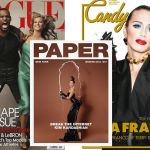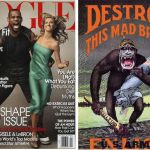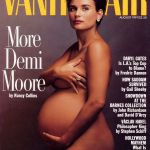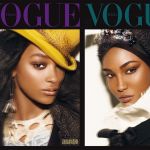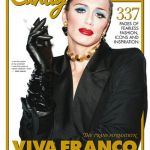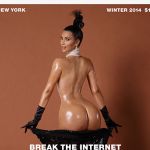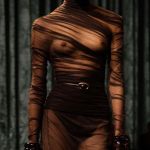The time-hallowed relationship between fashion and socio-politics can in many ways be seen as mutualistic. Throughout decades designers have taken inspiration from the occurring times to formulate collections centred around the general conversation. In turn, pioneers and protesters have often used clothing as a subliminal vessel to help solidify their messages. However, the moderators at the helm of this relationship have always been fashion magazines. It has been said that as facile of an art as it may at the time seem, fashion paired with journalism holds the power to not only reflect the times but also influence changes (negative or positive), especially in the process of shaping the impressionable minds of an upcoming generation.
Even with such great potential, not all publications choose to push the envelope in sparking conversation, some for fear of negative reception, and others for a matter of unparalleled aesthetics. However, the ones who do choose to go beyond the boundaries often do so with covers that create viral dialogue around the negative or positive impacts they carry. Let’s have a look back at 10 of the most controversial fashion magazine covers of all time.
American Vogue - April 2008
In April 2008, for the first time in its history,
American Vogue chose a black man to be included on one of its eminent covers. World-renowned basketball player
LeBron James was chosen to pair up with Brazilian model
Gisele Bundchen. However, it was the tableau in which they were captured what caused the world to think twice about the publication’s morals and intentions. LeBron was pictured with his face in an “ape-like” growl while he bounced a basketball with one hand and held the waist of a smiling Miss Bundchen with the other. This image was much too resemblant of the famous image of
King Kong clutching the form of actress Fay Wray. The magazine made no official statement in response to the uproar and although some may argue that their intent might not have been to provoke racist imagery, critics believed that given the level of care devoted to
American Vogue covers, that it was in fact deliberate. Either way, being one of the top fashion magazines in the world, the argument of intent is often proven irrelevant in comparison to impact.
Vanity Fair (America) - August 1991
Long ago, in an era before the internet, actress
Demi Moore was ridiculed for posing
nude whilst seven months pregnant on the cover of
Vanity Fair. At the time Demi, 28 years old, was married to actor Bruce Willis and bearing her second child as she posed naked with one hand holding her breasts and the other under her bump. Compared to the insouciance of nudity in the media today, it’s hard to imagine how much of a big deal this was. However, as it sold out from newsstands and supermarkets across the world, many dubbed the issue as provocative and borderline pornographic. Then
Vanity Fair Editor Tina Brown was herself shocked by the amount of attention the cover drew, “
little did I know it would become a media sensation, on every radio, TV and newspaper outlet — not just in America but all over the world,” she commented in response. The subject herself Demi Moore was equally surprised, “
I was stunned at some of the negative responses. That people found it pornographic, or they thought it wasn’t family-oriented. I think it’s so interesting that they’ll have other nudie type magazines out there, but the fact that I was pregnant would all of a sudden be something that isn’t family,” she told Roger Ebert. Since then, this cover has sparked a movement of conversation and imagery on shifting the attitudes towards sexuality and pregnancy.
Vogue Italia - July 2008
The late
Franca Sozzani,
Vogue Italia’s previous editor-in-chief, was never one who was afraid to push the boundaries. In July 2008, she created one of the most historic issues in fashion history featuring
all black models in a time where the race was still a major problem in fashion. The first run of the issue was said to have been
sold out in the US and UK within 72 hours of its release urging the publication to print another extra 30,000 copies. As successful as it may have seemed, it was not all good. Some, such as
The Guardian writer Priyamvada Gopal claimed that black women had little to gain from the issue. “
This is black girl as white girl: all aquiline noses, large eyes, oval faces, hair coaxed into silky straightness or carefully turbaned away in shot after shot. By simultaneously marking blackness as "special" and yet ensuring conformity to dominant (white and European) ideas of sophistication and beauty, the "black issue" tells us a great deal about race and ethnicity in the media today." Which indeed are valid, necessary points, and although it might not have been perfect, it was effective in initiating the conversation.
Vanity Fair (America) - July 2015
In July 2015,
former Olympic gold medal-winning decathlete Caitlyn Jenner graced the cover of
Vanity Fair as the first images to be released since her very public
transition. Before then, no one with such a high profile had ever come out as trans and on the day the cover was released, Jenner gained over a million Twitter followers in four hours, beating a record set by Barack Obama. Although a monumental moment in fashion and socio-politics, many members of the trans community were displeased for the praise the celebrity was almost instantly gifted by the public for her bravery, disregarding the daily fight average trans people encounter daily. The cover was the spark of a conversation around trans awareness while at the same time, aided in the misrepresentation and generalisation of the trans community at large.
Rolling Stone - February 2006
Kanye West as Jesus Christ on the cover of the magazine’s February issue was expectedly problematic. The artist was featured in portrait with a thorn crown around his head and what appeared to look like blood on his face. This was especially controversial when the magazine decided to title the written interview
The Passion of Kanye in reference to the film documenting Christ’s crucifixion
The Passion of the Christ. The artist has long compared himself to Jesus which notably began with the release of his 2004 single
Jesus Walks, and continued with his album
Yeezus that featured songs like
I am a God. This cover broke a long-lasting conversation around the artist’s vanity as well as religious debate on how divine we view ourselves as humans.
Dazed & Confused - September 2012
Controversial American rapper
Azealia Banks posed for the cover of Dazed & Confused in September 2012 with an
inflated bright pink condom between her lips accompanied by the cover line “
Azealia Banks Blows Up.” The cover not only sparked sensitive conversation around safe sex but was said to have also been banned in seven countries. The Dazed team tweeted “Just been told our upcoming @AZEALIABANKS cover has been banned from 7 countries so far. Thank God for the internet huh?” in response to the uproar.
Vogue Italia - September 2011
The Italian publication under the director of Franca Sozzani once again found itself in the hot seat after its release of a cover featuring Scottish model
Stella Tennant with a 13-inch waist dressed in a Deborah Milner corset over a Prada coat. The cover was said to be an ode to
Ether Granger — the woman with the world’s smallest waist. Although some were in applauded the brilliance of photographer Steven Meisel’s work, many were displeased with the message it may have promoted in regards to female body standards.
Candy Magazine - Winter 2010
American actor
James Franco was pictured on the cover of
Candy Magazine’s Winter issue in 2011 in full
drag. Shot by
Terry Richardson, the image featured Franco in latex gloves, an oversized tuxedo jacket, a choker with matching earrings. The actor fully embodies the drag persona as he posed in a face full of makeup. With this cover, the magazine was dubbed the first fashion publication to celebrate transversal style and cross-dressing, which of course was accompanied by a backlash from the transphobic community.
Vogue Paris - December 2010
Although not a cover, in 2010, French Vogue found itself under major scrutiny after releasing advertising images featuring
ten-year-old model Thylane-Lena-Rose-Blondeau dressed in heavy makeup and golden stilettos as she posed seductively on leopard print bed covers. At the time the magazine was being guest edited by designer Tom Ford and received major backlash for the sexualization of children.
Paper Magazine - Winter 2014
American
Paper Magazine is still known to have
broken the internet with its infamous cover featuring celebrity
Kim Kardashian. The cover featured two images shot by photographer Jean-Paul Goude in tribute to one of his past works “Carolina Beaumont, New York, 1976.” The first image featured Kardashian wearing a black sequinned gown while popping a bottle of champagne which lands in the glass placed on her buttocks. While cover two she stands with her back turned to the camera with the dress lowered and her assets exposed. Within 24 hours of its release, the magazine was said to rack up
over five and half million Google searches for “Kim Kardashian Paper Magazine.” Needless to say, the cover raised endless discussion around the topics of sexuality, motherhood and slut shaming.
